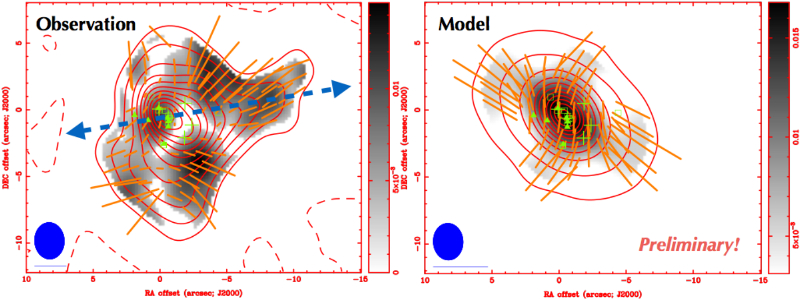| EPoS Contribution |
|
Misaligned magnetic field in a massive protocluster
Vivien Chen NTHU, Hsinchu, TW | |
| The influence of magnetic fields on dynamics and timescales of star formation remains an open question. The alignment of magnetic field with respect to mass accretion flow renders greatly different anticipation for kinematics. Mapping polarization is one of the most important techniques to trace magnetic fields. Polarized emission arising from magnetically aligned dust grains in the mm/sub-mm wavebands is often used to map the 2D morphology of the 3D magnetic fields on the plane of sky. As part of the SMA polarization legacy project, we have observed the polarized dust emission at 882um in the nearby (1.83 kpc) massive protocluster W3 IRS5 with an angular resolution of 2.7" (~5000 AU). W3 IRS 5 is a luminous proto-cluster with at least eight hyper-compact HII regions and makes a much younger analogue to the Trapezium system. Our polarization maps show a pinched morphology while the CO emission suggests two pairs of bipolar outflows. We have developed radiative transfer models to interpret the observed polarized dust emission and found a misaligned hourglass geometry of magnetic field. This suggests that the magnetic field does not necessarily remain well-aligned at scales of cluster formation. | |
 | |
| Caption: (Left) Polarization map of the massive protocluster W3 IRS5 at 882μm with the total intensity (Stokes I) map (contours) overlaid on the linearly polarized intensity map (grayscale). Line segments give polarization orientation with their length proportional to the polarization percentage. Arrows indicate the axis of the primary CO bipolar outflow. Triangles are 2.2μm HST/NICMOS sources, and crosses indicate SMA continuum sources. Open squares are VLA K-band compact sources. (Right) Model polarization map produced with observation simulation. The model assumes a rotating infalling envelope in the presence of an hour-glass geometry of magnetic field, which is misaligned with respect to the minor axis of the core and the outflow axis. | |
| Collaborators: Q. Zhang, CfA, US |
Key publication
Suggested Session: Magnetic Fields |

